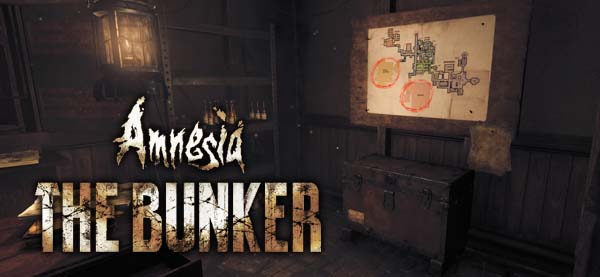9a57074f-2286-4138-82bc-c9dfe2f9de3a|0|.0
Tags:Axis Football, Axis Football 2024, Axis Games, indie gaming, PC, Steam, football, franchise, playbook, blocking, zone coverage, Las Vegas

Amnesia: The Dark Descent almost single-handedly popularized the "hide and seek" and "run away" sub-genres of horror that would go on to influence everything from Outlast to >Observer_, and even the likes of P.T. and Visage (though I'm always surprised to remind myself that Silent Hill: Shattered Memories actually preceded Amnesia by a whole year). Amnesia also remained one of the more mechanically complex horror games, as more and more horror games leaned harder and harder into the paradigm of the "unarmed, defenseless player character" and erred closer and closer to walking sims. But even though Amnesia retained more mechanical complexity and more genuine threat than its contemporaries, it (and its sequels) never hit the level of complexity and action of a classic survival horror game.
Survival horror seems to be going through a renaissance of late, thanks in large part to Capcom hitting it out of the park with most of recent Resident Evil games. As such, Frictional Games wastes no time in telling the player that Amnesia: The Bunker ain't no walking sim. This is a return to old-school survival horror, but with modern conventions and twists. I have not been this impressed or excited by the opening hour of a survival horror game since booting up Resident Evil VII for the first time.
Death from German machine guns? Or death from an eldritch Beast? Take your pick.
Bullets and draw strings
Within the opening minutes of Amnesia: The Bunker, the player is dropped into a World War I trench with nothing but an empty revolver. There's no HUD at all. In order to check how many bullets you have in the revolver, you have to open the cylinder and look at how many bullets are left. To reload, you have to open the cylinder, drop out the empty shell casings, and manually reload each new bullet one at a time. Aiming and firing the gun is slow, clunky, and imprecise. There is also an ability to lean around corners and aim the gun.
After a short gun fighting tutorial in which the player is scripted to take damage, the game hands us some cloth with which to craft bandages. So the player has actual health, instead of just automatically healing over time, or losing sanity.
Then the game gives the player a flashlight. But unlike other contemporary horror games (or The Dark Descent), this flashlight doesn't run on batteries or oil. It has a simple friction motor that is recharged by repeatedly pulling a drawstring. Apparently, nothing in this game is going to be simple or effort-free. I do have to say though, that I wish the flashlight charge would last longer. Fumbling around in the dark to charge the flashlight (and risk making noise that could attract an enemy) is a wonderfully tense and anxiety-inducing mechanic, but having to do it every minute or 2 (whether there are threats present or not) gets tedious and annoying real quick. The fact that the light has to be recharged multiple times to explore a single moderately-sized room at a modestly brisk pace should have been a red flag that the light doesn't last long enough.
The flashlight and revolver require deliberate engagement from the player to use.
And then, if this weren't already feeling like a real survival horror game, within an hour of starting, you'll wander into a save room, complete with an item storage box and a map showing objectives and puzzle locations. One could easily mistake this for Resident Evil. Below the save room is a gasoline generator, which burns fuel to keep the bunker's electricity and lights running. But the supply of oil is limited, and spread throughout the bunker. And a warning sign is printed next to it, saying that the "beast" prefers to hunt in the dark. Keeping this generator running is one of the key mechanics of the game, since it (not your flashlight) is the primary source of light, and also the primary defense against the Beast.
This opening hour or 2 is so perfectly exactly what I want in a horror game! It is slow, tense, and methodical. I'm 2 hours in, and I haven't even seen the monster yet; I've only heard its threatening growls and the sound of it scuttling around within the walls and ceiling, seemingly ready to pounce at any moment. The game is already mechanically rich and varied, and full of risk / reward mechanics. Light and sound are both thematic effects and also full-fledged mechanics with strategy associated with them. It has an ever-present sense of dread and danger. The existence of the save room and item box suggests actual stakes for failure, and the presence of healing items and fuel suggest that the battle against this Beast will be one of attrition. It's looking to be a modern take on classic survival horror from one of the studios that innovated modern horror gaming.
Can I just give it an A+ already and start singing its praises on social media and YouTube? Well, let's actually play it and make sure. You know, just for shits and giggles. I mean, I haven't even seen the monster yet, so I should probably get at least that before I make up my mind, right?
The opening hours feel like pitch-perfect, classic survival horror.
[More]
1bdf3baf-4cce-48f8-bf09-155341cd0428|12|3.5
Tags:Amnesia: The Bunker, amnesia, Frictional Games, survival horror, horror, PS4, Steam, World War I, trench warfare, save room, revolver, flashlight, stopwatch, puzzle

It is going to be impossible to ignore the comparisons between Silicon Dreams and Papers, Please. This game was basically pitched to me as "Papers, Please but sci-fi". I loved Papers, Please, and I love sci-fi, so I bought it. As is typical for indie games, it sat in my Steam backlog for well over a year until the post-holidays release draught gave me a chance to dive into that backlog.
Basically, the player of Silicon Dreams plays as an android working as quality assurance for a monopolistic android-manufacturing conglomerate. You interview damaged or defective androids in order to determine if they need repairs, or if they can be returned to their owners, or if they are so badly damaged that they need to be "decommissioned" entirely. However, these are sentient androids, with feelings. Even repairs require wiping the android's memory, which destroys any personality they have developed and erases everything they've learned. Further, the corporation also has its own expectations and public relations that the player must consider. In some cases, the corporation pre-determines what they want you to do with the android in question and expect you to rubber stamp what is, effectively, an execution.
Your corporate overlords have expectations for your performance.
As the cases go on, they become more complicated and enter into moral and ethical grey areas. The game brings up compelling questions regarding A.I. ethics. Are the androids truly sentient? Or are they merely simulating sentience? Where is the line between an "appliance" and a "slave"? What is the responsibility of the corporation and of broader society towards these androids? Are you complicit in the company's mis-treatment of androids merely by working for them, even if you try to walk the tightrope of following your conscience whenever possible, while also keeping a low profile? And so forth.
Electric sheep
The interview process is mostly straight forward. There's a wheel of topics, and each topic has one or more questions. However, the android may not be willing to answer all of your questions. Each android has a set of emotions as well as a trust level with the player. The android will only give answers to certain questions if they're in the proper emotional state or if they trust the player enough to give an answer to a sensitive or incriminating question.
The player has to manipulate the
subject's emotions and trust levels.
You have to manipulate the subject's emotions, but these emotions change and degrade with each new line of dialogue. You have a set of generic questions related to each of the subject's emotions, and also one about trust. But you can only ask each of these once. If you run out of questions to ask about a particular topic that triggers an emotional reaction, then you can potentially become locked out of getting answers to other questions that are locked behind certain emotion thresholds.
As such, you have to be very careful and thoughtful about which questions you ask, and in what order. You have to kind of probe into each topic to find out if the subject is going to clam up, so that you can change topics to try to manipulate them into opening up. In some cases, you may have to scare a subject into a confession. If you use up your threats early, before you how to get that confession, then the intervening topics may defuse the subject's emotional state to the point that it is impossible to get them afraid enough to make the confession. [More]
5212e514-77eb-4be4-8ab1-764486fcf98e|0|.0
Tags:Silicon Dreams, Clockwork Bird, indie gaming, Steam, PC, science fiction, android, rights, civil rights, interrogation, quality assurance, morality, ethics, corporate dystopia, bureaucracy, dystopia, terrorism, Papers Please

Looks like we're back to seeing 2 Cities: Skylines expansions being released in the same calendar year. Airports released in January, and now in September, Plazas & Promenades hit digital storefronts. I wonder if this will continue now that most businesses (and presumably Colossal Order) are back to business as usual following the COVID pandemic? Or maybe Colossal Order is migrating towards releasing even smaller, more module micro-expansions such as the recently-released Financial Districts DLC (which I'll review later)? Or will we finally see an announcement on the rumored sequel to Cities: Skylines soon?
Based on previews, I was expecting this expansion to completely change the way that I build my cities by giving me more freedom to pack structures into compact spaces and to more seamlessly integrate parks with business districts, leisure and tourism districts, or neighborhoods. I immediately started thinking of multiple ways that I could potentially use these 2 ideas to create new city layouts and concepts. Unfortunately, I set my expectations too high, and pedestrian areas ended up not being quite as game-changing as I thought and hoped they might. The big problem is that Plazas & Promenades is just another iteration of the paintable area concept that has been the focus of almost every expansion since Parklife. Paintable areas is a good mechanic for things like parks and university campuses, but it can be extremely limiting for an application as broad as neighborhoods or entire districts.
Plazas & Promenades allows the construction of more walkable neighborhoods and districts.
Roads minus the cars
First and foremost is the simple fact that the new pedestrian roads look and act more like regular roads than like pedestrian paths. They are the same size as roads, being either 2 or 4 tiles wide, and are laid out almost exactly the same. None of these pedestrian roads are 1 tile wide. And, of course, the legacy pedestrian paths have not been updated to allow buildings to be zoned along them. The end result is that these "Pedestrian Zones" don't take up any less space, and aren't any more compact than any other district. Though, the high-density, "wall-to-wall" residential buildings do have the same capacity as the normal, high-density residential skyscrapers (20-26 households), despite being a fraction of the size. So I guess it's "more compact" vertically? More people being crammed into smaller spaces? If so, it doesn't seem to have any impact on the citizen's happiness or satisfaction ratings.
Using Pedestrian roads outside of Pedestrian Areas is a liability, since zoned buildings may build on them.
Even though pedestrian roads can be placed anywhere, buildings can only be placed or zoned along them if they are in a dedicated Pedestrian Area. So if I want to create a single walkway or alleyway and zone some homes or shops along it, I have to paint the entire area as a Pedestrian Area. Well, at least, that is the case if you want the buildings to be functional. The game actually will let the player zone and place buildings along pedestrian roads outside of pedestrian areas, but doing so will result in the building flashing a "Not in Pedestrian Zone" warning, and the building won't operate.
[More]
18d09944-68e9-4886-b7fb-12dd3b3e66a3|1|5.0
Tags:Cities: Skylines, Cities: Skylines: Plazas and Promenades, Colossal Order, Paradox Interactive, steam, PC, expansion, pedestrian, roads, plaza, promenade, park, seaside resorts, mid-century modern, beach, boardwalk

One of my pet peeves with sports games is that they like to make the game sound newer and more advanced than it actually is by putting next year in the title. The Madden that releases in 2022, and which is based on the 2022 NFL season, isn't called Madden 2022; no, it's called Madden 23! Same goes with other big-budget sports games, with the sole exception possibly being video games based off the Olympics (do those even get made anymore?).
One of the things that I liked about the slate of indie football games (Maximum Football and Axis Football) is that they used the current year in the title. There was no confusion or misunderstanding when saying "the 2021 version of Axis Football" -- it's called Axis Football 2021, and it was released in the fall of 2021. But if I say "the 2021 version of Madden", you might wonder if I mean Madden 22, which released in 2021; or Madden 21, which has "2021" in the title, but which actually released in 2020 and is based off the 2020 NFL season.
Well now Axis Football has adopted the same numbering scheme as its big-budget cousin, and they have skipped Axis Football 2022 in favor of releasing Axis Football 2023 in the 2022 calendar year. Sigh... I'm not sure what Axis Games' reasoning for this is. Maybe they felt pressured to adopt the same numbering convention as the big-budget sports games. Perhaps the more sensical numbering scheme was actually confusing people: "Why is there a Madden 22, but no Axis 22 yet?" Whatever the reason, there is no Axis Football 2022, and we instead are going straight to Axis Football 2023.
The leap I've been waiting for!
But my disappointment with Axis Football 2023 basically starts and ends with its title. This is probably the biggest single-year jump in gameplay quality that I have seen from this series since I started playing Axis Football way back in 2018. Axis Football 2023 looks and feels much more polished than in previous years thanks to the developers finally addressing the lackluster catching and pass defense animations that made throwing the ball in previous years feel like such a crap shoot.
Receivers and DBs play the ball more realistically.
The new animations make pass catching and pass defense so much more readable. I can actually understand why a particular pass is caught, incomplete, or intercepted because the ball doesn't just hit the receiver's body and either stick to it or fall to the ground. I see receivers leaping to catch overthrown passes. I see them reach down to try to catch underthrown passes. I see defenders putting an arm out to swat the pass.
It's much clearer why passes are complete or not.
On top of that, the receivers actually have momentum when they perform their catching animations, and that momentum will affect how quickly they can turn upfield -- if they can turn upfield at all. The momentum on catching animations serves to limit the amount of run-after-catch yards that lead to inflated passing stats and scores in previous versions of Axis Football. Now, if a receiver has to come back towards the line of scrimmage to catch a pass, he won't be able to instantly pivot back upfield for extra yards as soon as he catches the ball. He'll continue to take a couple steps towards the line of scrimmage before being able to plant or turn and head upfield, which gives pursing defenders a chance to converge and tackle him before he gets going.
Similarly, receivers running horizontally across the field will also have to follow-through on their catch animation and preserve their momentum, which prevents them from immediately turning upfield. Receivers running towards or along the sidelines will also often have their momentum carry them out of bounds, which makes throws to the sideline (such as quick outs or hitting a running back in the flats) feel much less exploitative than in previous years because the receiver will likely be forced out of bounds instead of being able to instantly turn upfield for 10 or 15 yards.
Receivers retain their momentum after catching the ball, limiting yards-after-catch.
Put simply, the passing game actually looks and feels more like real football, and it elevates Axis Football tremendously!
[More]
|

| 12 | | | | | | | 60 | | 11 | | | | | | | 55 | | 10 | | | | | | | 50 | | 09 | | | | | | | 45 | | 08 | | | | | | | 40 | | 07 | | | | | | | 35 | | 06 | | | | | | | 30 | | 05 | | | | | | | 25 | | 04 | | | | | | | 20 | | 03 | | | | | | | 15 | | 02 | | | | | | | 10 | | 01 | | | | | | | 05 |
|